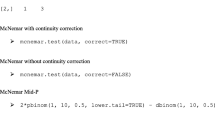Abstract
My purpose here is to provide a coherent account of inclusive fitness techniques, accessible to a mathematically literate graduate student in evolutionary biology, and to relate these to standard one-locus genetic models. I begin in Sect. 2 with a general formulation of evolutionary stability; in Sect. 3 and Sect. 4 I interpret the basic stability conditions within genetic and inclusive fitness models. In Sect. 5 I extend these concepts to the case of a class-structured population, and in Sect. 6 I illustrate these notions with a sex ratio example. In Sect. 7 I give a proof of the result that under additive gene action and weak selection, an inclusive fitness argument is able to verify an important stability condition (2.5) for one-locus genetic models. Most of these results have been published.
Similar content being viewed by others
References
Abrams, P. A., Matsuda, H. and Harada, Y. 1993. Evolutionarily unstable fitness maxima and stable fitness minima of continuous traits. Evol. Ecol.7: 465–487.
Bulmer, M. G. 1986. Sex ratio theory in geographically structured populations, Heredity56: 69–73.
Charlesworth, B. 1980a. Models of kin selection. In: Evolution of Social Behaviour: Hypotheses and Empirical Tests, (ed. H. Markl), Verlag Chemie, Weinheim.
Charlesworth, B. 1980b. Evolution in age-structured populations. Cambridge Studies in Mathematical Biology, Cambridge Univ. Press
Charnov, E. L. 1977. An elementary treatment of the genetical theory of kin selection, J. Theor. Biol.66: 541–550
Christiansen, F. B. 1991. On conditions for evolutionary stability for a continuously varying character, Amer. Nat.138: 37–50
Crow J. F. and Kimura M. 1970. An Introduction to Population Genetics Theory, New York: Harper and Row
Eshel, I. 1983. Evolutionary and continuous stability, J. Theor. Biol.103, 99–111
Eshel, I, and Motro, U. 1981. Kin selection and strong evolutionary stability of mutual help, Theor. Pop. Biol.19, 420–433
Forsyth, A. 1981. Sex ratio and parental investment in an ant population. Evolution36: 1252–1253
Frank, S. A. 1986. Hierarchical selection theory and sex ratios. I. General solutions for structured populations, Theor. Pop. Biol.29: 312–342
Grafen, A. 1984. Natural, kin and group selection, in Behavioural Ecology, An Evolutionary Approach (J. R. Krebs and N. B. Davies, eds) 62–84. Sinauer
Grafen, A. 1985a. A geometric view of relatedness, Oxford Surveys in Evolutionary Biology2: 28–89
Grafen, A. 1985b. Hamilton's rule OK, Nature318: 310–311
Hamilton, W. D. 1964. The genetical evolution of social behaviour, I and II, J. Theor. Biol.7: 1–52
Hamilton, W. D. 1970. Selfish and spiteful behaviour in an evolutionary model, Nature (Lond.)228: 1218–1220
Hamilton, W. D. 1972. Altruism and related phenomena, mainly in social insects, Ann. Rev. Ecol. Syst.3: 192–232
Hamilton, W. D. 1975. Innate social aptitudes of man: an approach from evolutionary biology. In: Biosocial Anthropology (R. Fox, ed.) pp 133–155. New York: John Wiley and sons
Iwasa, Y. 1981. Role of sex ratio in the evolution of eusociality in haplodiploid social insects, J. theor. Biol.93: 125–142
Jacquard, A. 1974. The Genetic Structure of Populations (trans. D. and B. Charlesworth) Biomathematics Series 5, Springer, New York
Leslie, P. H. 1948. Some further remarks on the use of matrices in population mathematics, Biometrika35: 213–245
Maynard Smith, J. 1974. The theory of games and the evolution of animal conflicts, J. theor. Biol.47: 209–221
Maynard Smith, J. and Price, G. R., 1973. The logic of animal conflict. Nature246: 15–18
Metz, J. A. J., R. M. Nisbet and Geritz, S. A. H. 1992. How should we define ‘fitness’ for general ecological scenarios? TREE7:198–202
Michod, R. E. and Hamilton, W. D. 1980. Coefficients, of relatedness in sociobiology, Nature288: 694–697
Pamilo, P. and Crozier, R. H. 1982. Measuring genetic relatedness in natural populations: methodology. Theor. Pop. Biol.21: 171–193
Price, G. R. 1970. Selection and covariance, Nature227: 520–521
Queller, D. C. 1985. Kinship, reciprocity and synergism in the evolution of social behaviour, Nature318: 366–367
Seger, J. 1981. Kinship and covariance, J. theor. Biol.91: 191–213
Taylor, P. D. 1981. Sex ratio compensation in ant populations. Evolution35: 1250–1251
Taylor, P. D. 1988a. An inclusive fitness model for dispersal of offspring, J. theor. Biol.130: 363–378
Taylor, P. D. 1988b. Inclusive fitness models with two sexes. Theor. Pop. Biol.34: 145–168
Taylor, P. D. 1989. Evolutionary stability in one-parameter models under weak selection, Theor. Pop. Biol.36: 125–143
Taylor, P. D. 1990. Allele frequency change in a class-structured population, American Naturalist135: 95–106
Taylor, P. D. and Getz, W. M. 1994. An inclusive fitness model for the evolutionary advantage of sib-mating. Evol. Ecol. 8: 61–69
Taylor, P. D. and Frank, S. A. 1996. How to make a kin selection model. J. theor. Biol. (in press)
van Tienderen, P. H. and De Jong, D. 1986. Sex ratio under the haystack model: polymorphism may occur. J. theor. Biol.122: 69–81
Author information
Authors and Affiliations
Rights and permissions
About this article
Cite this article
Taylor, P.D. Inclusive fitness arguments in genetic models of behaviour. J. Math. Biology 34, 654–674 (1996). https://doi.org/10.1007/BF02409753
Received:
Revised:
Issue Date:
DOI: https://doi.org/10.1007/BF02409753




